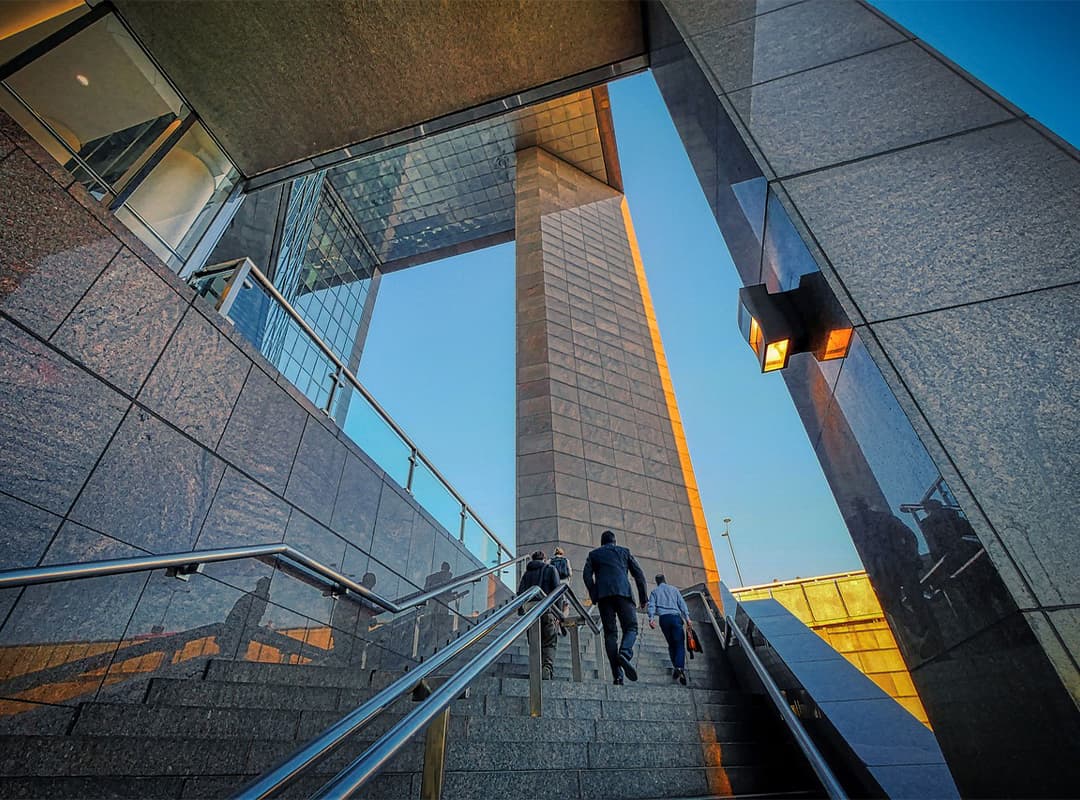The U.S. Chamber of Commerce was founded at a meeting of delegates on April 22, 1912. An important catalyst for the establishment of the U.S. Chamber of Commerce was two previous business agreements between the United States and Japan. In 1908, Eiichi Shibusawa invited the first official modern US business delegation to visit Japan. This delegation was headed by the prominent banker/economist Frank A. Vanderlip and accompanied by sixty business representatives from the West Coast states of California, Oregon, and Washington. The goal was to establish diplomatic ties between their countries and promote business and trade growth.
Night view of the Chamber of Commerce building, c. 1924.
In 1909, in appreciation of the hospitality shown to the 1908 Vanderlip business delegation during their visit to Japan, an invitation was extended to Japanese businessmen to visit the United States. This invitation came from the Associated Chambers of Commerce and Industry of the Pacific Coast, whose membership included eight major cities from the western coastal states of California, Oregon, and Washington. The Japanese accepted their invitation, and in 1909, Shibusawa, accompanied by his delegation of more than fifty of Japan’s most prominent business leaders and prominent personalities, visited 53 cities in America over the course of three months.
Their travels were covered in many newspapers as they traveled in a specially equipped “million dollar train” provided by the American industrial community. The U.S. government recognized the importance of their visit and sent U.S. representatives to accompany and assist them during the trip. Six representatives of the Associated Chambers of Commerce of the Pacific Coast also accompanied them to facilitate events along the way.
Their meetings included many chambers of commerce, tours of factories, power plants, fire departments, port facilities, mines, farms, schools, universities, libraries, theaters, churches, hospitals, and many other facilities. Their main goals are to develop friendship and familiarity between the two nations, while encouraging bilateral trade and commerce. An important impact of their visit was that it united the chambers of commerce in the United States, which likely prompted them to recognize the benefits of forming a national organization. President Taft was one of the U.S. leaders Shibusawa and his delegates met with during their visit.
The Chamber was created by President Taft as a counterweight to the labor movement of the time. John H. Fahey was the first chairman, and Harry A. Wheeler was the first president, with Elliot Hersey Goodwin as the first secretary. It opened its first office in the Evans Building. In 1913, President Taft spoke at the first banquet at the Willard Hotel, where he urged the organization to lobby for comprehensive currency legislation and support the Commission on Economy and Efficiency. During the first year of the U.S. Chamber of Commerce’s existence, the membership consisted of 297 commercial organizations and 165,000 firms and individuals. The U.S. Chamber’s staff grew dramatically in just ten years after its creation. In 1912, there were only four employees.
During a 1919 U.S. Chamber board meeting, Harry A. Wheeler proposed an idea that surprised many within the Chamber itself. The idea was to create a national headquarters. During this proposal, Wheeler stated that the Board of Directors should take this vote very seriously when deciding whether or not to establish a national headquarters, as it would have to pay for it with its own money. Nevertheless, the Board of Directors did not hesitate to respond and began the process of establishing the headquarters. Wheeler and Edson had already planned the location of the headquarters. The location was across from the White House on the corner of Lafayette Square. The only thing that prevented them from building was two 19th century mansions: the Corcoran House and the Slidell House. Nevertheless, the mansions were purchased for $775 thousand.
The U.S. Chamber of Commerce headquarters in Washington, D.C., occupies the land that was once the home of Daniel Webster.
Promoting business
Throughout its history, the U.S. Chamber of Commerce has promoted business and economic development. The Chamber’s first referendum in January 1913 called for a national budget. This call for a national budget created the Budget and Accounting Act of 1921. From that point on, the Chamber worked to assist the U.S. government during both World Wars and the Great Depression. In the 1960s, the Chamber was thinking differently about the business community. However, they did not have a world war to wage against crime and poverty.
During the oil crisis of 1973, the Chamber pushed for the expansion of domestic production. This included oil and gas exploration as well as coal mining and the Trans-Alaska Pipeline. In 1981, the Chamber launched the “Rebuild America” campaign to help support President Reagan’s Economic Recovery and Tax Act. With the rise of globalization in the 1990s, the Chamber promoted increased opportunities for exporting American goods and services, hoping to create jobs for Americans.
While the various chambers of commerce can work with all levels of government, they tend to focus their efforts on specific levels: local chambers of commerce tend to focus on local issues, state chambers on state issues, and the U.S. Chamber of Commerce on national issues. at the federal government level. They also work closely with a number of youth organizations across the country on the importance and role of business in our modern society.
In 1993, the Chamber lost several members over their support of the Clinton health care reform. At the time, the Chamber decided to support health care reform because of the dramatic increase in health care costs faced by its members. However, House Republicans responded by calling for a boycott of the organization. By the time health care reform became a serious issue again in 2010-2012, the organization had opposed such efforts.
Although the Chamber claims to represent more than 3 million American companies, according to data, 94% of its revenue comes from about 1,500 large companies.
In recent years, as Republicans have supported increased trade restrictions and strong anti-immigration policies, and Democrats have embraced immigration, free trade, and other business-friendly policies, the composition of the Chamber’s political support has changed. In 2019, the Chamber updated the formula for its scorecard used to determine endorsements to “more fully reward members of Congress for helping to advance pro-business policies while encouraging members to make the compromises necessary to govern effectively.”
After Donald Trump refused to concede after the 2020 presidential election and a majority of GOP members of Congress supported attempts to overturn the election results based on false claims of fraud, the Chamber of Commerce issued a memo to its members stating that it would “review the totality of its members’ actions” and “take note…of future behavior that corrodes our democratic institutions.”
In 2021, Chamber lobbyist Neil Bradley said that any lawmakers who support the PRO Act would have to pay a “political price,” which the Chamber called “a list of almost every failed idea in the last 30 years of labor policy.”




